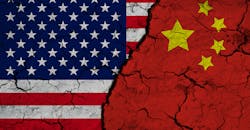The Fallout from Frayed Goodwill with China Will Be Swift and Intense
Opinion/Analysis
Doubtless, few in the United States need to be alerted to the challenge of higher costs associated with supply shortages. It’s the old “supply and demand" principle: When product availability goes down, prices go up. This phenomenon is a factor driving the inflation our country is currently experiencing. It is not pleasant—but necessary—to point out that there will soon be an additional inflationary driver on goods and services that U.S. firms source from China.
As COVID started disrupting all aspects of business and industry, including supply chain, U.S manufacturers began leaning heavily on the existing goodwill they had with their Chinese suppliers to resolve supply-chain-related issues. This has been possible because the Chinese historically have believed in building relationships with their business partners. Goodwill is a critical factor of such a policy. However, over the last couple of months it’s become apparent that the goodwill reservoir is draining fast.
Inflation is as big an issue in China as it is in the United States. Official inflation figures put out by the government may or may not be accurate, but we can trust what we see with our own eyes. Inflation has hit China with a vengeance, and manufacturers there do not believe it will be “transitory”—and rightly so.
As in this country, inflation in China cannot be attributed to a single cause. Rising energy prices, commodity shortages driving higher prices, rapidly increasing shipping costs, etc. have all contributed to a level of inflation not previously see in China. Understandably, there is much anger in China at the United States since they also see our country’s economic policies as a major contributor to their country’s inflation.
You may ask “How so?” Let me explain.
The U.S. dollar is the world’s reserve currency and as such, it is the medium of exchange for most international trade. A significant percentage of all dollars in circulation globally have been printed in the last couple of years as tax revenues have gone down with the double-whammy of the 2017 corporate tax reduction and the impact of COVID on world trade. It is not necessary to be an economist to understand the impact this has had on governments holding U.S. debt. For instance, China currently owns more than a trillion dollars of American debt and is seeing its value erode on a daily basis. Talk about downgrading goodwill.
Consequently, inflation in the United States drives inflation in all world markets. And because of our country’s dependence on selling its debt to foreign governments and investors, many countries see the United States, in effect, “exporting” its own inflation by reducing the value of the dollars they hold.
Our country’s port fiasco is another cause of frustration with Chinese manufacturers. The current situation is this: Out of every four containers shipped from China to the U.S., only one is returned in a normal timeframe as ships wait in ports. This shortage has severely restricted China’s ability to service its other international customers. Sentiment in China is now growing that shipments to other countries should be prioritized since containers used for those shipments are returned in short order. There is not shipping shortage; there is a container shortage. And there will continue to be until the U.S. starts returning some of the containers currently piling up at its ports.
All of this has led to pressure for Chinse manufactures to increase their prices. And these price increases will be significant. There are projections here that within the next six months to a year pricing on some export goods will increase up to 20%. In the past, goodwill between Chinese suppliers and U.S. customers would tend to dampen this upward pressure. Today, that goodwill is much reduced, and the Chinese are being more financially pragmatic. Consequently, there can be little doubt that product being ordered from China for delivery next year will increase in price, further contributing to this country’s inflationary pressure.
And the current thinking in China is that U.S. manufacturers have little leverage to resist these price increases since there is a world-wide shortage of commodities and parts, and that as a result, it will take significant time for current U.S.-based manufacturing customers to re-source to other suppliers. And anyway, reductions in orders from the U.S. aligns with the Chinese government’s industrial plan to become less dependent on trade with the United States.
Companies whose supply chain extends to China should be prepared to revise their material acquisition budgets. The advice I’d give to any company dealing with China is to focus on relationships. Make contact, explain the issues and problems you are experiencing—and based on the level of remaining goodwill, they may try to make some accommodation.
Eamon McKinney, Ph.D., M.B.A., (sinologist) is an expert on China-related business issues in the world. He has contributed numerous articles on the subject to publications including the Financial Times, the Economist and the Far Eastern Economic Review.
